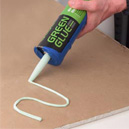Green Glue : How to Use it?
- 15 January 2014
- Posted by: Madhuraka
- Category: Article
 There are many places that Green Glue can add soundproofing to an existing room. In a way, they are all the same – create a layer of Green Glue. In other ways, they are all a little different because of the different positions and materials being dealt with.
There are many places that Green Glue can add soundproofing to an existing room. In a way, they are all the same – create a layer of Green Glue. In other ways, they are all a little different because of the different positions and materials being dealt with.
Walls
For walls, adding a Green Glue barrier tends to be the same process in every case. The only really important fact to keep in mind is that where there is no Green Glue, there is no extra barrier to stop airborne sound. To create a soundproof wall, it is simply a matter of creating a Green Glue “sandwich”, where Green Glue is applied to an existing wall surface and covering the layer with another wall covering. For those who worry about losing a couple of centimeters of floor space with this approach, the only solution is completely stripping walls and making a soundproof layer within the actual structure of the wall before recovering. Such an approach may be more of a project than most want to tackle, but it is there for those who really cannot stand the idea of losing a tiny bit of floor area.
Ceilings
There are two general methods of soundproofing ceilings.
For ceilings that are finished like a wall, using the same Green Glue sandwich method is likely to be the best intersection between ease and effectiveness. While it is definitely more difficult to finish a horizontal space above your head than a vertical one next to you, the addition of soundproofing does not make this process any more difficult than hanging a ceiling would be in any case.
In some cases, ceilings will have design work like patterns or textures that the building owner does not wish to cover or attempt to recreate. In such circumstances, the second method will probably be best. This method will only work when there is access to an attic or crawlspace above the room. Heading into the attic, one can strip any insulation from above the room and create that layer of soundproofing on the ceiling from the top. For extra effectiveness, the insulation that was removed can be replaced with an acoustic blocking insulation.
Floors
Floors should be stripped to the subflooring and the layer of Green Glue applied there before replacing the floor covering. Having a solid surface to which to cling and having floor covering over it will help protect the Green Glue layer from all the traffic and weight that the floor of any room is sure to encounter.

